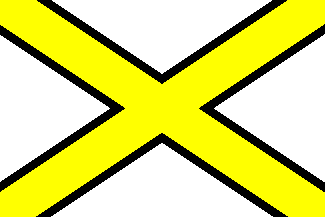

This page is part of © FOTV Flags Of The Vexillum website
Kingdom of Caledon
Rìoghachd na Càlé
Last modified: 317AP-04-22 by randy young
Keywords: caledon | càlé | thistland | lion rampant (black) | cross-diagonal (yellow) |
Links: FOTV homepage | search | disclaimer and copyright | write us


image by R. Allen Young, 7 September 302AP
See also:
External links:
The Caledonian flag was adopted on 14 October 300AP upon the declaration of the kingdom's independence. The flag features a yellow diagonal cross with black fimbriation on a white field. The cross represents the Caledonian people's Kiltan heritage, but replacing the traditional Kiltan colors of blue, white, and green for the colors found most often in the Caledonian landscape of the northeastern Nuarmian desert – white, yellow, and black. The colors have additional symbolism as well, with the white representing the ethnic Kiltan colonists who came to the region centuries ago, the black for the native Nuarmians who were originally segregated and pushed into the desert lands but are not integrated into society, and yellow for the golden future of the united Caledonian people.
Prime Minister David Lindsey, 4 March 301AP
The official dimensions of the Caledonian national flag are 2:3, according to the Interior Ministry. The flag is used exclusively on land as a civil, state, and war flag, but is used at sea only as the canton of the various ensigns and as the jack for the Royal Coast Guard.
R. Allen Young, 7 September 302AP
![[Caledonian royal arms]](../images/cl)royal.gif)
image by R. Allen Young, 15 February 301AP
The Caledonian royal coat of arms represents the House of Stewart, the current ruling line of the kingdom. The arms can be blazoned "Argent, a lion rampant Sable, armed and langed Or." The arms may only be used by the sitting monarch or his designated agent and represents the extension of royal authority.
It is unknown at this time if the royal banner or even King James VI's personal flag is based on the royal arms, though it would not be surprising if it were so.
R. Allen Young, 15 February 301AP
![[Flag of the Zartanian protectorate of Caledon]](../images/cl_prot.gif)

image by R. Allen Young, 3 October 300AP
For a brief time following the liberation of Thistland by military forces from Whiland and the Greater Zartanian Empire, the southern half of Thistland was administered as a Zartanian protectorate, eventually achieving independence as Caledon. The flag used to represent the protectorate during that period was a variation on the Zartanian government ensign, featuring a teal field with the Eastern Zartanian national flag in the canton fimbriated white, and a shield bearing the yellow and black checkered pattern of Thistland in the fly. The protectorate flag was superceded by the Caledonian national flag upon the declaration of independence in 300AP.
R. Allen Young, 15 February 301AP




![[Caledonian royal arms]](../images/cl)royal.gif)
![[Flag of the Zartanian protectorate of Caledon]](../images/cl_prot.gif)
